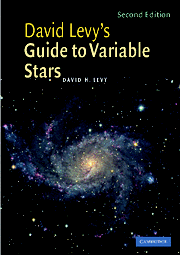Book contents
- Frontmatter
- Contents
- Foreword to the first edition
- Preface
- Acknowledgments
- Part I Getting to know the sky
- Part II Getting to know the variables
- Part III Suggested variables for observation throughout the year
- 26 Introduction
- 27 January, February, March
- 28 April, May, June
- 29 July, August, September
- 30 October, November, December
- 31 Southern sky notes
- Part IV A miscellany
- Index
29 - July, August, September
from Part III - Suggested variables for observation throughout the year
Published online by Cambridge University Press: 05 August 2012
- Frontmatter
- Contents
- Foreword to the first edition
- Preface
- Acknowledgments
- Part I Getting to know the sky
- Part II Getting to know the variables
- Part III Suggested variables for observation throughout the year
- 26 Introduction
- 27 January, February, March
- 28 April, May, June
- 29 July, August, September
- 30 October, November, December
- 31 Southern sky notes
- Part IV A miscellany
- Index
Summary
The northern hemisphere nights at this time of year are short but busy, for there is always something to do.
We begin with the most prominent feature of the northern sky, the “summer triangle” of Vega, Deneb, and Altair. In and around this triangle are many fine variables, including SS Cygni, a dwarf nova whose bimonthly explosions have made it one of the most popular variable stars of all.
A good star with which to begin is Beta Lyrae, a star offering nightly variation, and the parallelogram of Lyra offers two additional stars that work well as comparison standards. Next you can move to Aquila, whose Eta provides changes over a slightly longer period. We then can check on our old friends X and g Herculis and RR Coronae Borealis.
At this time of year we can turn our sights to Corona Borealis, the crown of Ariadne where our friends R and T Coronae Borealis lurk in the evening sky. We also can enjoy some of the Crown's more traditional long-period variables, like W, whose striking red color helps in finding.
Cygnus offers so many variables that you could hardly begin to see them in a single season. The constellation's most famous variable is Chi, a star lying in the middle of the Swan's neck. This season also features Sagittarius, whose collection of over 2500 variable stars surely must contain something of interest to a beginner. And there is: RY Sgr is a star like R Cor Bor.
- Type
- Chapter
- Information
- David Levy's Guide to Variable Stars , pp. 194 - 212Publisher: Cambridge University PressPrint publication year: 2005

